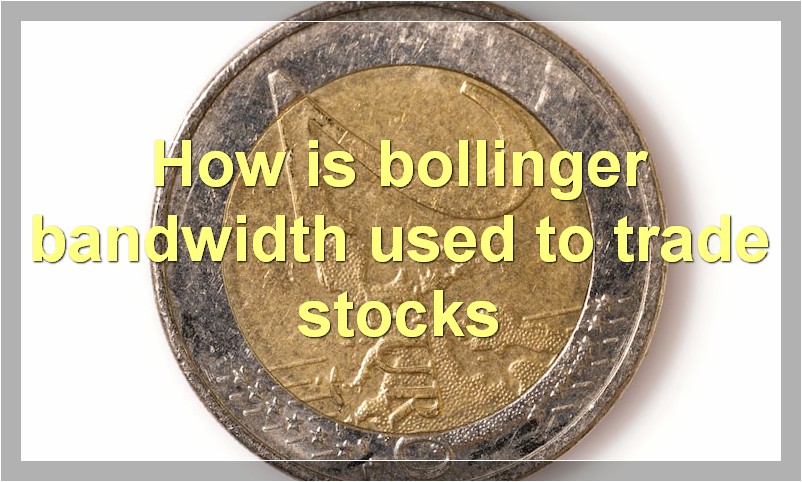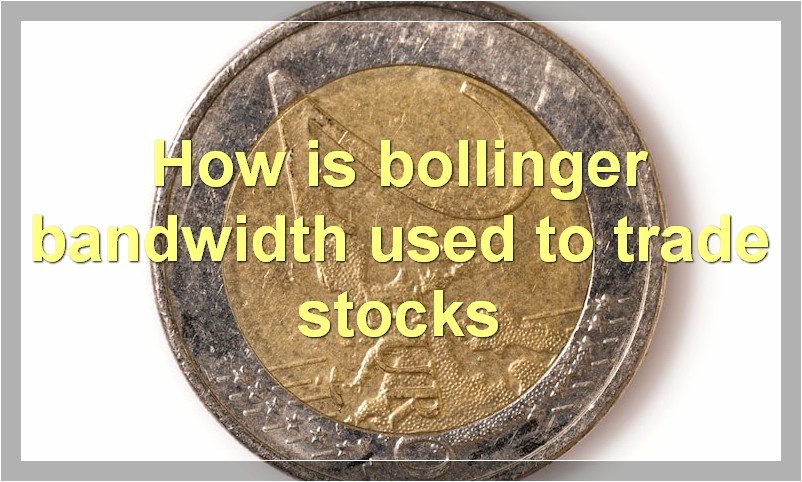If you’re looking to get started with Bollinger Bands, this is the guide for you. Bollinger Bands are a versatile tool that can be used to identify trends, volatility and potential reversals. This guide will walk you through everything you need to know about Bollinger Bands, including how to interpret them and how to use them in your trading.
What is bollinger bandwidth
Bollinger Bands are a technical indicator created by John Bollinger, which appear as a pair of lines on a price chart. The line in the middle is typically a 20-day simple moving average (SMA), while the upper and lower bands are usually set 2 standard deviations above and below the middle line. Bollinger Bands can be used to measure market volatility, identify potential trend reversals and set entry and exit points.
The Bollinger Bandwidth is the difference between the upper and lower Bollinger Bands. It is a good measure of market volatility and can be used to identify potential trend reversals. When the Bollinger Bandwidth is narrow, it means that the market is not very volatile and may be due for a move. When the Bollinger Bandwidth is wide, it means that the market is very volatile and may be due for a reversal.
How is bollinger bandwidth used to trade stocks

Bollinger Bands® are a technical analysis tool that provides a relative definition of high and low. They are calculated using a simple moving average and its standard deviation. The standard deviation is a statistical measure of volatility. Bollinger Bands® can be used to trade stocks by helping to identify when prices are relatively high or low. When prices are high, traders may sell stocks in order to take profits. When prices are low, traders may buy stocks in order to take advantage of low prices. Bollinger Bands® can also be used to help identify trends.
What are the benefits of using bollinger bandwidth
Bollinger bandwidth is a technical indicator that measures the percentage difference between the upper and lower Bollinger bands. This indicator is useful in identifying periods of low volatility and potential breakouts.
Some of the benefits of using Bollinger bandwidth include:
-The ability to identify periods of low volatility which can be used to enter or exit positions
-The ability to identify potential breakouts in price
-The ability to use Bollinger bands in conjunction with other technical indicators to form a comprehensive trading strategy
How does bollinger bandwidth help traders identify trends
Bollinger Bands are a technical analysis tool that is used to measure market volatility. The Bollinger Band consists of a upper and lower band that is placed two standard deviations above and below a simple moving average. The space between the two bands is referred to as the “bandwidth”. The bandwidth measures the width of the Bollinger Band and can be used as a tool to identify trends.
When the bandwidth is wide, it means that the market is volatile and there is a lot of price movement. This is usually seen during a trend. When the bandwidth narrows, it means that the market is consolidating and there is less price movement. This is often seen before a reversal or breakout.
What are some common misconceptions about bollinger bandwidth
Bollinger bandwidth is a technical indicator that measures the width of the Bollinger Bands, which are a set of price bands plotted above and below the price on a chart. The Bollinger Bands are based on a standard deviation calculation of the underlying price, and the Bollinger bandwidth is simply the width of the Bollinger Bands divided by the underlying price.
The Bollinger bandwidth is often used as a measure of market volatility, with wider bands indicating more volatility and narrower bands indicating less volatility. However, there are a few things to keep in mind when using this indicator:
First, the Bollinger bandwidth is not a measure of absolute market volatility, but rather a relative measure. That is, it will tell you how volatile the market is relative to its recent history. So, if the market has been relatively calm for a period of time and then suddenly becomes very volatile, the Bollinger bandwidth will increase even though the absolute level of market volatility may not have changed all that much.
Second, the Bollinger bandwidth is based on the standard deviation of prices, which is a statistical measure that is subject to sampling error. This means that there is some degree of uncertainty associated with the Bollinger bandwidth readings.
Finally, keep in mind that the Bollinger bandwidth is just one tool that can be used to measure market volatility. There are other indicators out there that can provide complementary or even conflicting information. As with any technical indicator, it’s important to use the Bollinger bandwidth in conjunction with other technical and fundamental analysis tools in order to get a complete picture of what’s going on in the market.
How can bollinger bandwidth be used to improve trading strategies

Bollinger Bands are a technical analysis tool that is used to measure market volatility. The bands are created by plotting a simple moving average (SMA) and two standard deviations above and below the SMA. Bollinger Bands can be used to improve trading strategies in a number of ways.
One way to use Bollinger Bands is to look for trading opportunities when the market is relatively calm. This can be done by watching for periods when the Bollinger Bands are tight (narrow) and prices are bouncing around in a small range. These conditions often precede a period of increased market volatility, which can provide opportunities for traders to enter or exit positions.
Another way to use Bollinger Bands is to look for breakout opportunities. This can be done by watching for price breakouts above or below the upper or lower Bollinger Band. These breakout signals can be used to enter or exit trades.
Finally, Bollinger Bands can be used to identify overbought and oversold conditions in the market. This can be done by watching for price action that touches or exceeds the upper Bollinger Band during periods of market rallies, or price action that touches or falls below the lower Bollinger Band during periods of market weakness. These overbought/oversold signals can be used to take profits or initiate new positions.
What are some challenges associated with using bollinger bandwidth
Bollinger bandwidth is a technical indicator that measures the width of the Bollinger Bands. The Bollinger Bands are a volatility indicator that is used to measure the standard deviation of price changes over a certain period of time. The bollinger bandwidth is used to signal when the market is overbought or oversold.
Some challenges associated with using bollinger bandwidth include:
1) Volatility – Bollinger bandwidth is a volatility indicator, which means that it is subject to change based on market conditions. This can make it difficult to use as a reliable signal for trading.
2) Time frame – The bollinger bandwidth indicator is based on the Bollinger Bands, which are calculated using a 20-day moving average. This means that the signal may not be as timely for shorter-term traders.
3) False signals – The bollinger bandwidth indicator can give false signals in a choppy market, or when prices are range-bound.
How can bollinger bandwidth be used to make better investment decisions
Bollinger bandwidth is a technical indicator that can be used to measure the volatility of a security. By using bollinger bandwidth, investors can make better investment decisions by identifying periods of high and low volatility. Bollinger bandwidth can also be used to predict future price movements, as high levels of volatility often coincide with sharp price movements.
What role does bollinger bandwidth play in technical analysis
Bollinger Bands are a technical analysis tool that was invented by John Bollinger in the 1980s. The bands are created by plotting a simple moving average (SMA) and then adding and subtracting a standard deviation to create an upper and lower band. The distance between the two bands is known as the bandwidth.
The idea behind Bollinger Bands is that price tends to stay within the upper and lower bands during periods of low volatility, but will break out of the bands during periods of high volatility. This breaking out of the bands can be used as a signal to enter or exit a trade.
Bollinger Bands can be used on any time frame, but they are most commonly used on daily or weekly charts.
What are some tips for using bollinger bandwidth effectively
Bollinger Bands are a technical analysis tool used by traders to measure market volatility. The bands are based on a standard deviation calculation of the underlying asset’s price. When the market is volatile, the bands expand, and when the market is calm, the bands contract.
Traders can use Bollinger Bands to trade a variety of strategies, but the most common is to buy when the price touches the lower band and sell when it hits the upper band. This strategy takes advantage of the fact that prices tend to revert back to the mean after periods of extreme volatility.
Another common strategy is to look for reversals when the price breaks out of the Bollinger Band. For example, if the price has been in a downtrend and then breaks above the upper Bollinger Band, this could be a sign that the trend is reversing.
There are many ways to use Bollinger Bands, but these are two of the most common. As with any technical indicator, it’s important to combine Bollinger Bands with other forms of analysis before making any trading decisions.

